Discover Jesus in every book of the Bible, from Genesis to Revelation, and unveil the cohesive story of redemption that invites deeper exploration.

Jesus in Every Books of the Bible
Journeying through the juxtaposition of Jesus in every book of the Bible offers an enlightening exploration.
You'll find Him not just in the New Testament narratives, but woven into the fabric of the entire biblical text, from Genesis's Promised Seed to Revelation's Reigning King.
This thread not only highlights His omnipresence but also illuminates the intricate tapestry of redemption spanning centuries.
If you've ever wondered how the Old Testament connects to Christ's life and teachings, this discussion promises to uncover those profound connections, inviting you into a deeper understanding of scripture's unity and the central role of Jesus within it.
Why does this matter? Well, that's the conversation we're about to have.
Key Takeaways
- The Old Testament foreshadows Jesus through prophecies, symbols, and typologies, emphasizing His messianic role and redemptive mission.
- In the New Testament, Jesus' life, teachings, and fulfillment of prophecies are documented, showcasing Him as the Messiah and Savior.
- Symbolic representations in books like Exodus and Numbers highlight Jesus as the source of salvation and spiritual nourishment.
- Jesus' role as the ultimate deliverer and mediator is mirrored in narratives and figures across both the Old and New Testaments.
Genesis: The Promised Seed

In the book of Genesis, a pivotal promise unfolds, introducing the concept of a Seed—a figure embodying salvation and redemption, foreshadowing Jesus's pivotal role in the biblical narrative. This promise emerges in the aftermath of the Creation narrative, where humanity's initial harmony with the divine is shattered by the Serpent's deceit. The narrative meticulously outlines how this betrayal not only fractures the relationship between humans and God but also sets the stage for a grand scheme of redemption. You're invited to delve into the intricate layers of this promise, discerning its profound implications for understanding Jesus's anticipated arrival.
The Serpent's deceit, a critical juncture in Genesis, catalyzes the unraveling of the created order, enticing humanity into disobedience. This act of rebellion necessitates divine intervention, which is subtly but powerfully promised through the prophecy of the Seed. This Seed, you'll notice, is prophesied to crush the Serpent's head, symbolizing the ultimate defeat of sin and evil—a clear anticipation of Christ's victory over death. This allegorical representation enriches your understanding of Jesus's mission, portraying it as a cosmic battle against the forces that seek to estrange humanity from its Creator.
Analyzing this promise requires you to appreciate the nuanced literary and theological craftsmanship of Genesis. The narrative doesn't merely recount the origins of the cosmos and humanity; it sets forth a divine plan for salvation that culminates in Jesus Christ. Through this lens, you're encouraged to see Genesis not just as a story of beginnings, but as the first chapter in a much larger story of redemption and restoration, masterfully woven through the tapestry of the Bible.
Exodus: The Passover Lamb
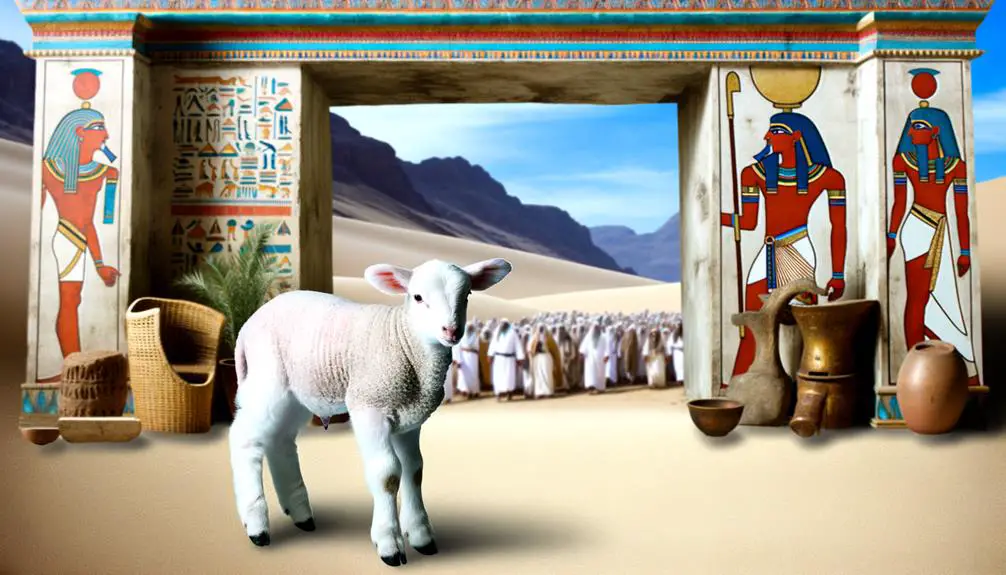
You'll find that in the book of Exodus, the Passover lamb embodies rich layers of symbolism tied to deliverance and redemption.
This sacrificial lamb foreshadows Jesus's role as the ultimate redeemer, whose sacrifice delivers humanity from the bondage of sin.
Analyzing this parallel, you gain a deeper understanding of the intricate ways the concept of salvation is woven throughout the biblical narrative.
Symbolism of the Lamb
The symbolism of the lamb in Exodus, specifically during the Passover, deeply embodies redemption and deliverance themes central to understanding Jesus's role throughout the Bible.
The lamb's innocence isn't merely an incidental detail; it's a profound representation of purity and unblemished character, which prefigures the sinless nature of Christ. This innocence underscores the sacrificial significance of the lamb, highlighting an essential aspect of atonement.
The act of selecting a lamb without blemish and offering it as a sacrifice encapsulates the principle of substitutionary atonement, where the innocent bears the penalty deserved by the guilty. This framework not only illuminates the sacrificial system in the Old Testament but also foreshadows the ultimate sacrifice Jesus would make, aligning with the broader narrative of salvation history.
Deliverance and Redemption
Having explored the symbolism of the lamb in Exodus as a representation of purity and sacrifice, let's now examine how this symbolism extends to themes of deliverance and redemption through the Passover lamb. This ancient narrative mirrors the concept of modern salvation, where the lamb's blood signifies unconditional grace, offering deliverance from spiritual bondage.
Aspect |
Ancient Context |
Modern Parallel |
|---|---|---|
Sacrifice |
Lamb's blood for protection |
Jesus' sacrifice |
Deliverance |
Escape from Egypt |
Liberation from sin |
Grace |
Unmerited favor |
Unconditional grace |
Redemption |
Freedom from slavery |
Salvation from sin |
Covenant |
Old Testament promise |
New covenant through Christ |
This juxtaposition highlights the enduring relevance of the Passover lamb as a rich symbol of deliverance and redemption, bridging ancient rituals with the essence of Christian faith.
Leviticus: The High Priest
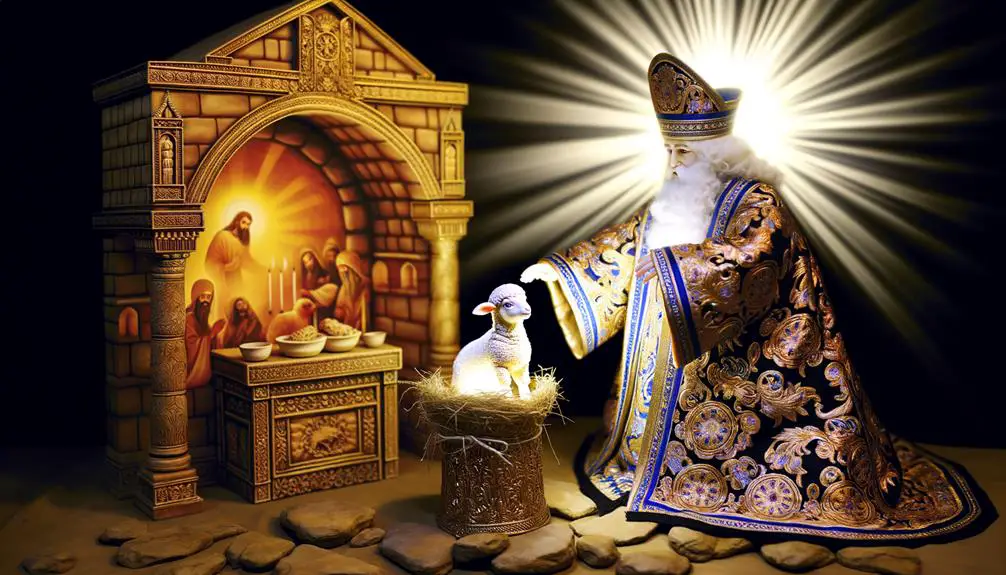
In examining Leviticus, you'll find the High Priest's role in priestly atonement rituals central to understanding Jesus' sacrificial function. These rituals, intricate in their execution, mirror the sacrifice Jesus made, offering a comprehensive framework for holiness.
Furthermore, the Holiness Code's reflection within this context underscores the meticulous standards required for spiritual purity, drawing a parallel to Jesus' sinless life.
Priestly Atonement Rituals
Delving into Leviticus, we uncover the intricate rituals of priestly atonement, where the High Priest acts as an intercessor between humanity and the divine. These ceremonies, laden with symbolism, not only purify the community but also restore its relationship with God.
As you explore these ancient practices, consider their modern implications and the ethical considerations they evoke in today's context. The act of slaughtering animals for sacrifice, central to these rituals, prompts a reevaluation of our own sacrificial systems and what they signify about our values and beliefs.
The High Priest's role underscores a shared responsibility for communal transgressions, challenging us to reflect on how we collectively address moral and spiritual failings. This deep dive into Levitical rites offers a lens through which to examine contemporary notions of atonement, redemption, and intercession.
Holiness Code Reflection
Exploring the High Priest's role within the Holiness Code of Leviticus further illuminates the profound implications of these rituals on concepts of purity, community, and divine interaction. The Holiness Code not only prescribes rituals but also lays a foundation for ethical living and community standards.
- Ethical Living: The High Priest models a life of ethical purity, guiding the community in their moral decisions.
- Community Standards: Through ritual observance, the High Priest reinforces the standards that bind the community together.
- Divine Interaction: The rituals embody the community's relationship with the divine, mediated by the High Priest.
- Purity: The High Priest's actions underscore the importance of both physical and moral purity within the Holiness Code framework.
Numbers: the Water From the Rock
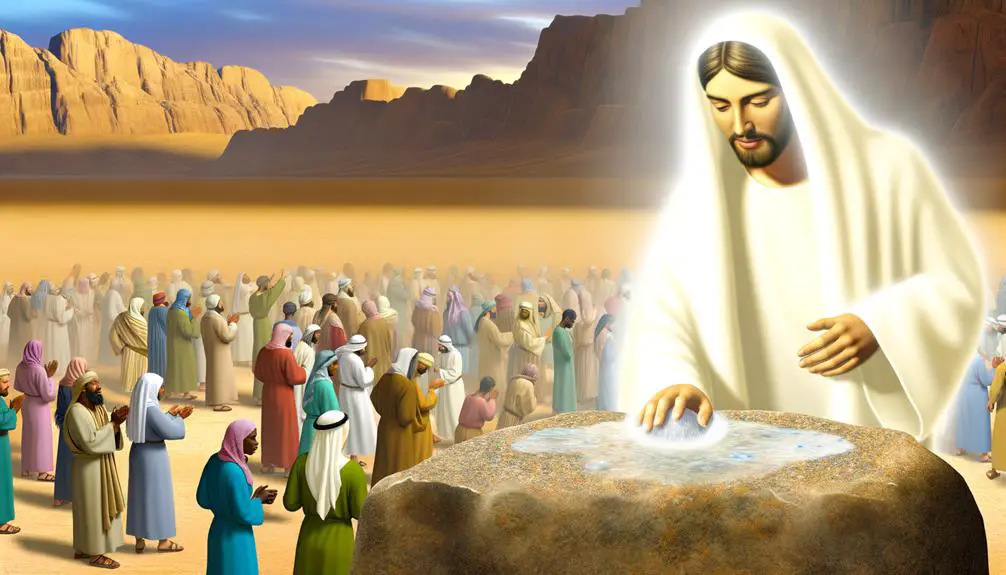
ARTICLE TITLE: Jesus in Every Book of the Bible
PREVIOUS SUBTOPIC: 'Holiness Code Reflection'
CURRENT SUBTOPIC: 'Numbers: the Water From the Rock'
Often, the narrative of water flowing from the rock in the Book of Numbers is seen as a profound prefiguration of Jesus Christ as the inexhaustible source of spiritual sustenance for humanity. This miraculous event not only showcases God's provision but also symbolizes the spiritual hydration that Jesus offers. Let's delve into the geological context and hydration symbolism inherent in this narrative.
Aspect |
Significance |
|---|---|
Geological context |
Highlights the miraculous nature of the event. |
Hydration symbolism |
Represents Jesus as the source of living water. |
In the arid wilderness, the Israelites' desperation for water reflects humanity's spiritual thirst. The rock, typically barren of water, miraculously yielding an abundance, underscores a divine intervention that defies natural explanation. This act foreshadows Jesus, who in the New Testament, declares Himself as the "living water," capable of quenching the deepest spiritual droughts of humanity.
The hydration symbolism extends beyond mere physical sustenance. It encapsulates the idea of spiritual rejuvenation and purification. Just as water is essential for physical life, Jesus's teachings and sacrifice are paramount for spiritual awakening and sustenance. The flowing water from the rock, therefore, is not just a miraculous provision but a profound metaphor for Jesus's role as the eternal source of spiritual life, offering hydration to a parched soul.
In this narrative, the confluence of geological improbability and deep hydration symbolism paints a vivid picture of Jesus's pivotal role in spiritual nourishment and refreshment.
Deuteronomy: The Prophet Like Moses
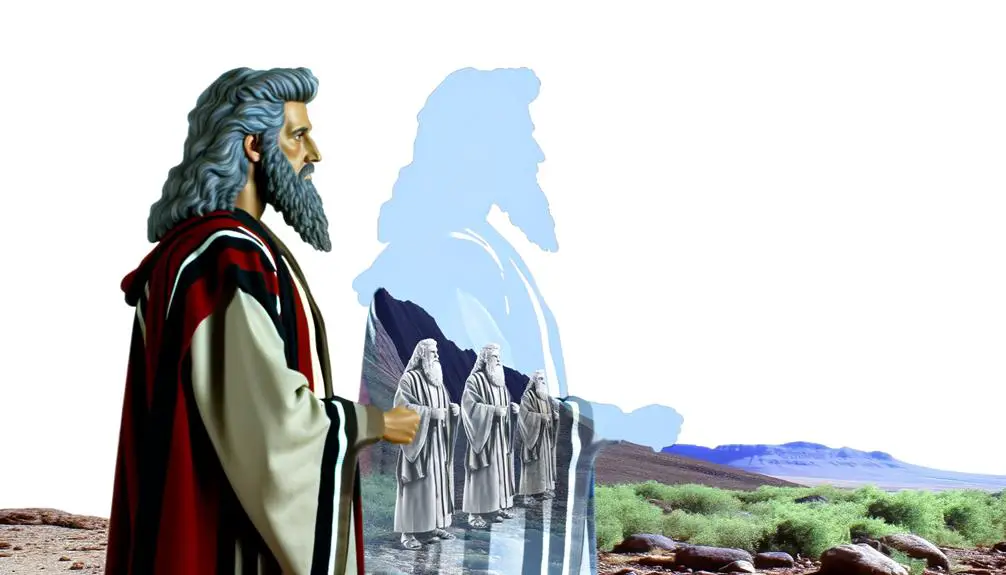
Moving from the symbolic representation of Jesus in the wilderness to a direct prophecy, Deuteronomy introduces us to the concept of a prophet like Moses, who Christians believe foreshadows Jesus Christ himself. This book, rich in its narrative and theological depth, places a significant emphasis on Moses' humility and the theme of covenant renewal, both of which are critical in understanding the parallel to Jesus.
Here are four key aspects to consider:
- Moses' Humility: Moses is depicted as the humblest man on Earth, a trait that's deeply reflective of Jesus' own humility. Despite their positions of authority, both leaders chose the path of humility, serving rather than being served.
- Covenant Renewal: Deuteronomy emphasizes the renewal of the covenant, which is a pivotal moment for the Israelites. This moment parallels the New Covenant established by Jesus through His death and resurrection, marking a renewal of the relationship between God and humanity.
- Prophet like Moses: God promises to raise up a prophet like Moses, who'll speak God's words faithfully. Christians see this as a clear prophecy of Jesus, who, like Moses, mediates between God and people but does so in a more profound and final manner.
- Obedience and Love: Both Deuteronomy and the life of Jesus highlight the importance of obedience to God's commandments and love as the foundation of the law. Jesus' teachings amplify this message, focusing on love as the greatest commandment.
Deuteronomy's portrayal of a prophet like Moses sets a foundation for understanding Jesus' role as the ultimate mediator and fulfiller of God's promises, emphasizing themes of humility, covenantal faithfulness, and love.
Joshua: The Commander of the Lord's Army
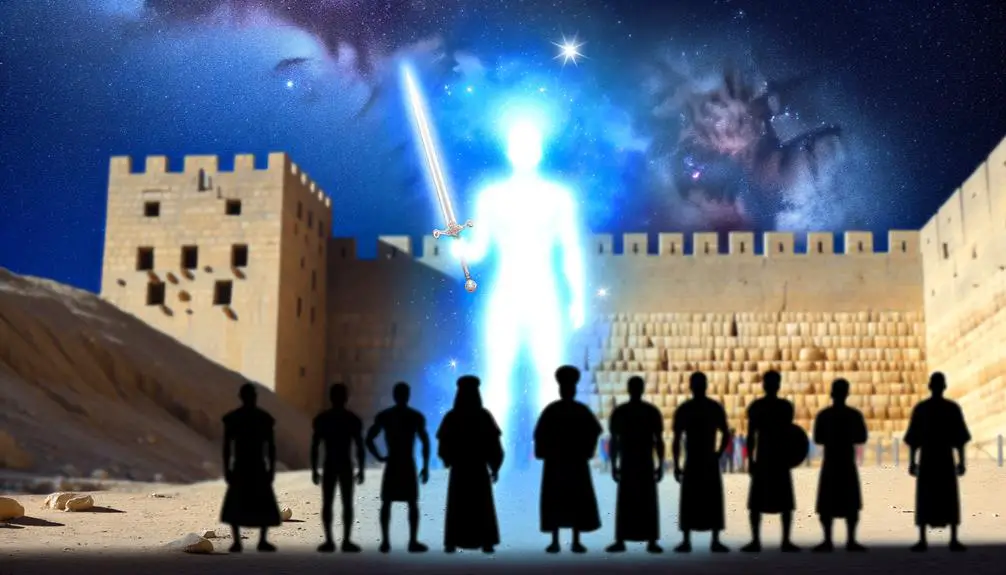
In the book of Joshua, we encounter the figure of Joshua himself, who serves as the Commander of the Lord's Army, presenting a typological foreshadowing of Jesus Christ's leadership and divine mission. Through Joshua's narrative, we discern a profound parallel to Christ's role as the ultimate leader and savior. Joshua's adeptness in battle strategies and his formidable leadership qualities not only facilitated the Israelites' conquest of the Promised Land but also mirrored the strategic and spiritual guidance Jesus provides to His followers.
Joshua's military campaigns, marked by divine intervention and strategic acumen, highlight a critical aspect of his leadership. He didn't rely solely on his understanding; instead, he sought God's guidance, reminiscent of Jesus's relationship with the Father, emphasizing obedience and trust. Joshua's victory at Jericho, achieved through unconventional tactics, underscores the importance of faith over might, a principle central to Christ's teachings.
Moreover, Joshua's leadership was characterized by righteousness and unwavering faith. His ability to lead by example, inspiring unity and faithfulness among the Israelites, aligns with Jesus's role in forging a new covenant community based on faith and obedience. The distribution of the land among the tribes under Joshua's leadership symbolizes the inheritance of the Kingdom of God promised to believers, further illustrating the typological link between Joshua and Jesus.
Analyzing Joshua as the Commander of the Lord's Army thus provides insightful reflections on Jesus's divine mission. Joshua's embodiment of leadership qualities and strategic battle strategies serves as an archetype, foreshadowing the greater fulfillment in Christ's perfect leadership and redemptive work.
Judges: The Righteous Deliverer
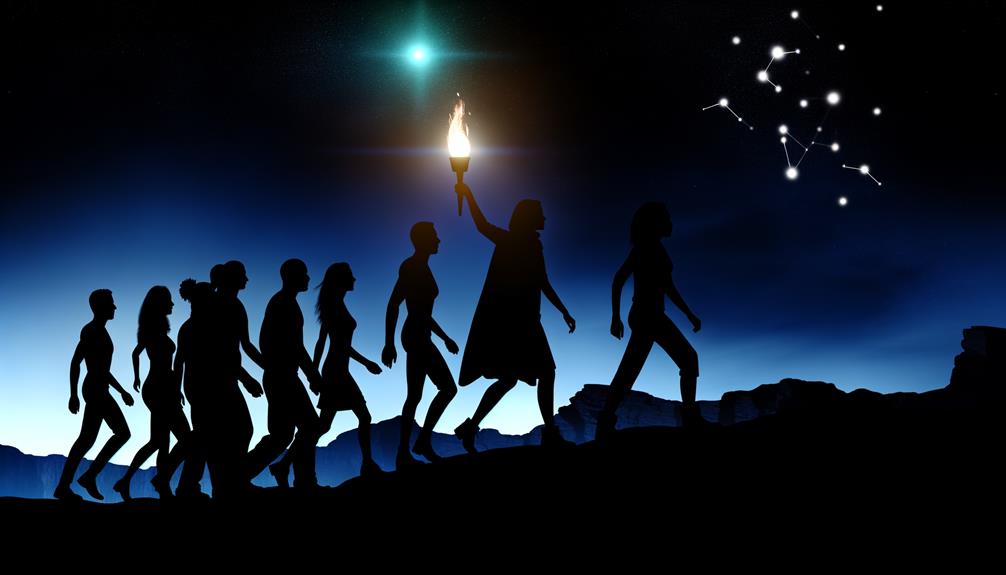
As we examine the book of Judges, it becomes evident how the cycle of Israel's disobedience and deliverance through divinely appointed leaders foreshadows the ultimate redemption offered by Jesus, the Righteous Deliverer. The narrative arc of Judges, with its repeated cycle of sin, suffering under oppression, crying out for deliverance, and the rise of a judge to bring salvation, mirrors the broader biblical theme of humanity's need for a savior and God's provision of Jesus Christ as that eternal deliverer.
In Judges, we witness the Israelites under Canaanite oppression, a direct consequence of their departure from God's ways. Yet, amidst this turmoil, God raises up judges as deliverers, among whom Deborah stands out for her leadership. This scenario encapsulates several key themes:
- Humanity's Tendency Toward Sin: Like the Israelites, we often stray from God's path, leading to spiritual bondage.
- God's Mercy in Providing Deliverers: Despite repeated disobedience, God compassionately raises leaders to rescue His people, prefiguring Jesus's role as our ultimate savior.
- The Role of Faithful Leaders: Deborah's leadership exemplifies faithful service to God, pointing to how Jesus leads and intercedes for His church.
- The Need for Divine Deliverance: Just as the Israelites needed a judge to deliver them from physical oppression, we need Jesus to liberate us from the bondage of sin.
Analyzing Judges through this lens not only enhances our understanding of the book itself but also deepens our appreciation of Jesus's unique role as the Righteous Deliverer, foreshadowed throughout the Old Testament, including in the turbulent times of the judges.
Ruth: The Kinsman Redeemer
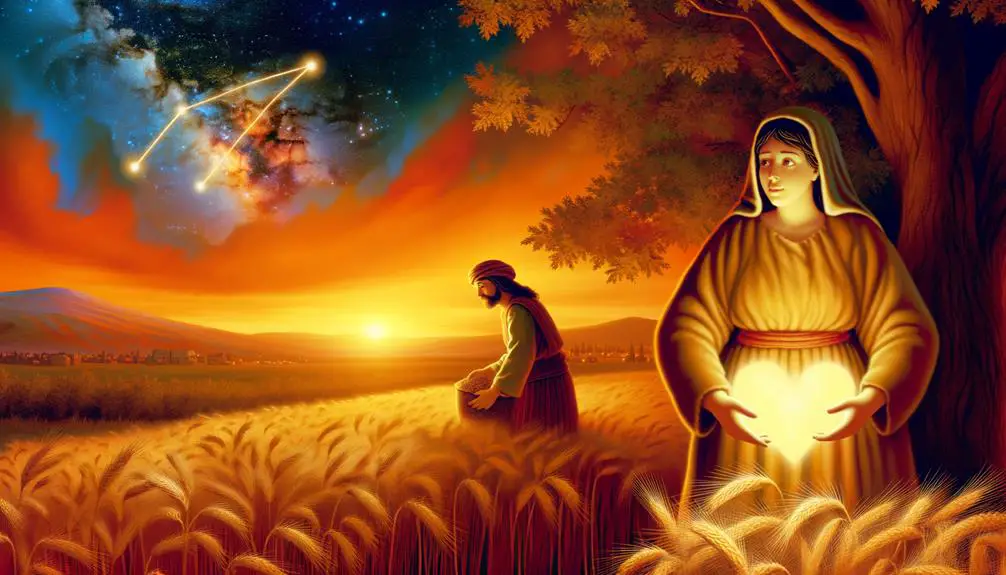
Delving into the book of Ruth, we uncover a profound illustration of Jesus's role as our Kinsman Redeemer, embodied in the story of Boaz's redemption of Ruth and Naomi from their destitution. This narrative, rich in harvest themes and marital loyalty, offers a layered understanding of redemption and covenant love, mirroring the salvific work of Jesus Christ.
In the account, Boaz, a relative of Naomi's late husband, embodies the role of the kinsman redeemer – a protector and provider under Mosaic Law, who marries Ruth to preserve the family lineage and restore their lands. This act of redemption isn't merely a legal obligation but is imbued with compassion and loyalty, reflecting Christ's sacrificial love for humanity. Boaz's willingness to redeem Ruth and Naomi from their plight illustrates Jesus's willingness to redeem us from sin and death, regardless of our background or status.
Moreover, the harvest themes present in Ruth signify abundance and providence, echoing the spiritual nourishment and sustenance that Jesus offers. As Boaz generously provides for Ruth during the barley harvest, so does Jesus offer Himself as the bread of life, satisfying our deepest hungers and securing our eternal inheritance.
The story of Ruth and Boaz also underscores the importance of marital loyalty and covenant commitment. Just as Boaz commits to Ruth, Jesus commits to His Church, establishing a new covenant through His blood. This marital imagery enriches our understanding of Jesus's relationship with us, highlighting His unwavering love and faithfulness.
Thus, through the narrative of Ruth, we gain a multifaceted perspective on Jesus as our Kinsman Redeemer, who lovingly redeems us and invites us into a relationship characterized by loyalty, provision, and unwavering commitment.
Frequently Asked Questions
How Do the Portrayals of Jesus in the Old Testament Books Compare to His Depiction in the New Testament?
You'll find that the Old Testament's portrayals of Jesus, focusing on genealogical significance and Messianic expectations, set a foundation for understanding his character. These elements foreshadow his fulfilling role in the New Testament.
There, he's depicted not just as a figure meeting these expectations but expands on them, embodying salvation and grace. This comparison reveals a meticulously planned narrative, showcasing a transition from prophecy to fulfillment, deeply rooted in both sections of the Bible.
Can You Provide Examples of How Early Christian Communities Interpreted These Old Testament Depictions of Jesus?
You're asking about how early Christian communities interpreted Old Testament depictions without the explicit context of finding Jesus in every book. They used various interpretative methods, deeply rooted in scriptural context, to uncover Christ's presence. This approach wasn't just about seeing him in prophecies but also in types, symbols, and institutions.
Their analytical, scholarly efforts aimed to connect the Old Testament's detailed narratives with the person and work of Jesus, enriching their faith and understanding.
How Have Different Denominations or Branches of Christianity Understood or Emphasized These Typologies of Jesus Differently?
You may find it intriguing that 78% of Christians feel denominational diversity enriches their faith.
This diversity significantly influences how different branches of Christianity interpret typologies of Jesus. Each denomination brings its unique perspective, leading to a rich tapestry of understanding.
This typological variance showcases the analytical depth within theological studies, revealing detailed insights into how Jesus's presence is woven through scripture, subtly differing in emphasis from one Christian tradition to another.
What Are Some of the Scholarly Criticisms or Debates Surrounding the Interpretation of Jesus in Every Book of the Bible?
You're diving into a complex topic where scholars argue about how interpretive methodologies and historical context shape understanding. Critics point out that some readings stretch texts beyond their original meanings, lacking historical grounding.
Others debate the consistency and validity of methodologies used across different biblical books. It's a detailed, scholarly discussion, examining if and how each book can genuinely reflect aspects of Jesus, challenging both traditional and modern interpretations.
How Do Jewish Scholars and Theologians Respond to Christian Interpretations of Jesus Being Foreshadowed in the Hebrew Bible (Tanakh)?
How do you reconcile differing beliefs?
Jewish scholars often challenge Christian interpretations of the Tanakh, highlighting its central role in Jewish identity without the messianic implications Christians see.
These scholars emphasize historical and contextual analysis over prophetic foresight, fostering rich interfaith dialogue.
Conclusion
In examining the scriptures, it's clear you'll find Jesus symbolically represented in each book of the Bible, embodying roles that signify His multifaceted relationship with humanity.
Take Genesis as an example, where He's foreshadowed as the Promised Seed, a profound promise of redemption intricately woven into the fabric of human history from the very beginning.
This analysis not only enriches our understanding of biblical narratives but also underscores the cohesive and prophetic nature of the Bible, revealing a meticulously planned salvation history centered around Jesus.

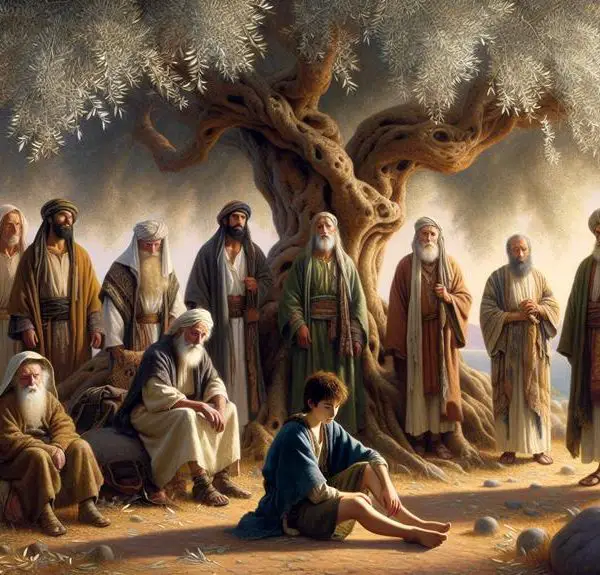
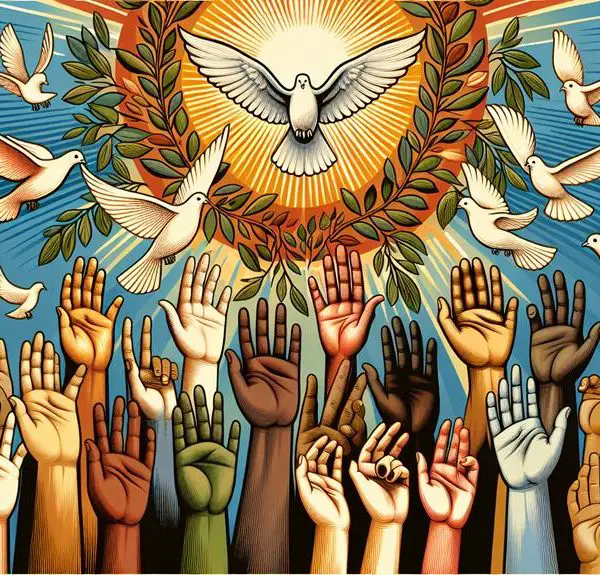
Sign up